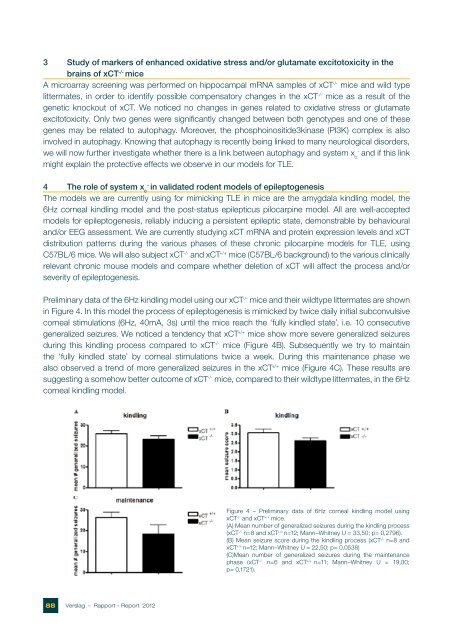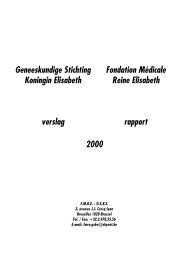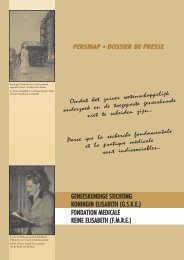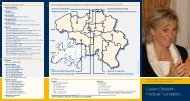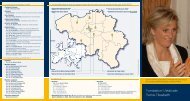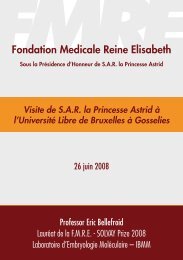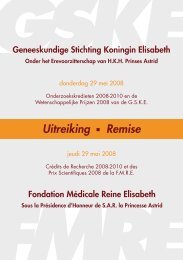Verslag – Rapport – Bericht – Report - GSKE - FMRE
Verslag – Rapport – Bericht – Report - GSKE - FMRE
Verslag – Rapport – Bericht – Report - GSKE - FMRE
You also want an ePaper? Increase the reach of your titles
YUMPU automatically turns print PDFs into web optimized ePapers that Google loves.
3 Study of markers of enhanced oxidative stress and/or glutamate excitotoxicity in the<br />
brains of xCT-/- mice<br />
A microarray screening was performed on hippocampal mRNA samples of xCT-/- mice and wild type<br />
littermates, in order to identify possible compensatory changes in the xCT-/- mice as a result of the<br />
genetic knockout of xCT. We noticed no changes in genes related to oxidative stress or glutamate<br />
excitotoxicity. Only two genes were significantly changed between both genotypes and one of these<br />
genes may be related to autophagy. Moreover, the phosphoinositide3kinase (PI3K) complex is also<br />
involved in autophagy. Knowing that autophagy is recently being linked to many neurological disorders,<br />
- we will now further investigate whether there is a link between autophagy and system x and if this link<br />
c<br />
might explain the protective effects we observe in our models for TLE.<br />
- 4 The role of system x in validated rodent models of epileptogenesis<br />
c<br />
The models we are currently using for mimicking TLE in mice are the amygdala kindling model, the<br />
6Hz corneal kindling model and the post-status epilepticus pilocarpine model. All are well-accepted<br />
models for epileptogenesis, reliably inducing a persistent epileptic state, demonstrable by behavioural<br />
and/or EEG assessment. We are currently studying xCT mRNA and protein expression levels and xCT<br />
distribution patterns during the various phases of these chronic pilocarpine models for TLE, using<br />
C57BL/6 mice. We will also subject xCT-/- and xCT +/+ mice (C57BL/6 background) to the various clinically<br />
relevant chronic mouse models and compare whether deletion of xCT will affect the process and/or<br />
severity of epileptogenesis.<br />
Preliminary data of the 6Hz kindling model using our xCT -/- mice and their wildtype littermates are shown<br />
in Figure 4. In this model the process of epileptogenesis is mimicked by twice daily initial subconvulsive<br />
corneal stimulations (6Hz, 40mA, 3s) until the mice reach the ‘fully kindled state’, i.e. 10 consecutive<br />
generalized seizures. We noticed a tendency that xCT +/+ mice show more severe generalized seizures<br />
during this kindling process compared to xCT -/- mice (Figure 4B). Subsequently we try to maintain<br />
the ‘fully kindled state’ by corneal stimulations twice a week. During this maintenance phase we<br />
also observed a trend of more generalized seizures in the xCT +/+ mice (Figure 4C). These results are<br />
suggesting a somehow better outcome of xCT -/- mice, compared to their wildtype littermates, in the 6Hz<br />
corneal kindling model.<br />
88<br />
<strong>Verslag</strong> <strong>–</strong> <strong>Rapport</strong> <strong>–</strong> <strong>Report</strong> 2012<br />
Figure 4 <strong>–</strong> Preliminary data of 6Hz corneal kindling model using<br />
xCT -/- and xCT +/+ mice.<br />
(A) Mean number of generalized seizures during the kindling process<br />
(xCT -/- n=8 and xCT +/+ n=12; Mann<strong>–</strong>Whitney U = 33,50; p= 0,2796).<br />
(B) Mean seizure score during the kindling process (xCT -/- n=8 and<br />
xCT +/+ n=12; Mann<strong>–</strong>Whitney U = 22,50; p= 0,0538)<br />
(C)Mean number of generalized seizures during the maintenance<br />
phase (xCT -/- n=6 and xCT +/+ n=11; Mann<strong>–</strong>Whitney U = 19,00;<br />
p= 0,1721).


